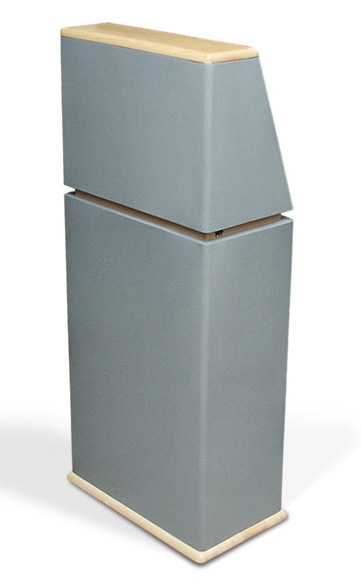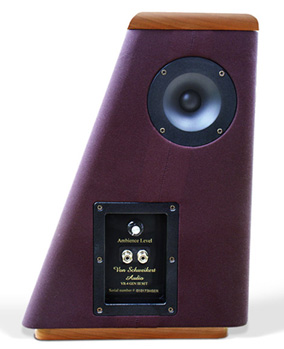You are reading the older HTML site
Positive Feedback ISSUE
18
march/april 2005
von schweikert audio
VR-4 III loudspeakers
as reviewed by Jim Olson

|
JIM OLSEN'S SYSTEM
LOUDSPEAKERS
ELECTRONICS
SOURCES
CABLES
ACCESSORIES |
The Von Schweikert VR-4 III loudspeaker is one step above the company's bread-and-butter VR4-jr (read Fown-Ming Tien's and Greg Weaver's reviews on the VR4-jr loudspeakers)), a speaker that has a broad appeal due to its reasonable cost, attractive styling, and exceptional build quality. Both speakers feature a Wilson-Watt-Puppy-popularized configuration that puts the midrange and tweeter enclosure on top of a separate chamber housing the low-frequency drivers. Going down the list of design features, the III appears to be an extraordinary value, featuring extremely high-quality, low-distortion drivers, film and foil capacitors, high-gauge air core inductors, and a massive cabinet with extensive internal bracing, among other impressive features not often found in loudspeakers at this price. Very high-quality binding posts and industrial-looking cloth wrap complete the enclosure. The VR-4 IIIs give a visual message of elegance and studio-like industrial design. I give them an A+ for build quality and appearance, as they compare well to any loudspeakers I have seen that sell for under $10,000/pair.
The VR-4 IIIs boast some very impressive technical features. The bass module is not just another vented or sealed cabinet, but a triple-chambered transmission line that is much more costly and challenging to implement than a standard box. And get this—the two 9-inch woofers have a claimed response of flat down to 20Hz! This is exceptional for 9-inch woofers, and should result in a unique sonic signature in the lowest octaves. The cabinet is heavily braced and constructed out of 1-inch MDF. The usual knuckle rap on the side of the cabinet confirms that the enclosure is massive and non-resonant. To further enhance the low-frequency performance, the cabinet is tuned by a 7-inch flared vent that allows for low turbulence and excellent dynamic range.
The midrange driver uses a very advanced cone material that is a combination of carbon and kevlar fibers, with a polymer surface coating. The cone is incredibly stiff, light, and damped, allowing a very fast transient response and low energy storage. The inside of the midrange cabinet is lined with thick acoustic felt.
 Some of the other claimed features include a
+/- 1dB frequency response tolerance, consistent phase and slow rotation
between drive units, time coherency in the ear's sensitive 3ms range, a
fourth-order acoustic slope crossover, and an ambience retrieval rear
tweeter in addition to the heavily damped silk dome tweeter on the front
of the midrange cabinet. The efficiency is rated as 89dB at 1W. This is
not a particularly demanding load, although the fourth-order crossover
network indicates that the VR-4 IIIs will probably like a high-quality
amplifier with a good damping factor.
Some of the other claimed features include a
+/- 1dB frequency response tolerance, consistent phase and slow rotation
between drive units, time coherency in the ear's sensitive 3ms range, a
fourth-order acoustic slope crossover, and an ambience retrieval rear
tweeter in addition to the heavily damped silk dome tweeter on the front
of the midrange cabinet. The efficiency is rated as 89dB at 1W. This is
not a particularly demanding load, although the fourth-order crossover
network indicates that the VR-4 IIIs will probably like a high-quality
amplifier with a good damping factor.
Topping the list of features is Von Schweikert's "Global Axis Integration Network," a fancy way of saying that the speakers have an even polar response pattern. The VR-4 IIIs are serious, well-thought-out, reference-quality loudspeakers. They made me feel like I was in the presence of highly accurate reproduction devices that have been designed to perform. Also inspiring confidence is their ten-year warranty, which is almost unheard of in the loudspeaker industry. With all those impressive design features, you would think that the VR-4 IIIs would deliver impressive performance, and perform they did.
The review system consisted of Mark Levinson 33H monoblock amplifiers and a Mark Levinson No. 320S preamplifier, which had a full, weighty, and totally controlled presentation. Also on hand was the superb DK Design Group VS-1 Reference Mk. 2 integrated amplifier (see the PFO review here), which proved to be a terrific match, and I briefly experimented with the PrimaLuna Prologue One integrated amplifier, which delivered a room-shaking, booty-groovin' 35 watts per channel. Digital was provided by the Linn UNIDISK player.
The IIIs proved sensitive to cabling. I started off with Nordost Blue Heaven (Revision 2), which gave a very detailed presentation with ultra fast transients, but were a little too lean and lacked oomph in the lowest registers. The Kimber Monocle XL had the best combination of midrange warmth and bass extension, while maintaining lightning-fast transients. The ideal listening position seemed to be with each speaker two feet from the rear wall, ten feet apart, and toed in about five degrees.
Especially given the small footprint of the speakers, and the fact that they employ two 9-inch woofers, I don't know of any other floorstanding speakers that can generate the bass or the overall energy of the VR-4 IIIs. These speakers rock, and provide an almost unlimited dynamic range for speakers of their size and type. The deepest bass notes had pitch-perfect precision and lots of speed and slam. On "Assault on Ryan's House," from the Patriot Games soundtrack (RCA 66051-2), the speakers shook the room with clean, solid reproduction of the deep synthesizer notes.
The biggest strength of these speakers, and the true measure of the designer's skill, is the seamless integration between the drivers. The taught, ultra-clean bass lacked any overhang or trailing edges, but this was not at the expense of the IIIs' midrange reproduction. The woofers handed over the music seamlessly to the midrange drivers, allowing the speakers to present the music with unbelievable coherency and correct timbre. This then extended into an effortless, ultra-detailed, yet romantic and smooth treble presentation that was probably characteristic of the silk dome tweeter. The treble of these speakers reminded me of that of the Dynaudio Esotar tweeters that are used in many ultra-high-end designs.
Well-recorded vocalists and instruments were reproduced with incredible speed and an unusually wide range. This, along with the resolution in the midrange and high frequencies and the lightning-fast transients at all levels, made the IIIs ideal for every musical genre. Pink Floyd's Shine On You Crazy Diamond (Capitol 29750) was spellbinding, with a massive soundstage that swept the room and lots of impact on dynamic peaks. The midbass clarity and articulation were substantial, giving these speakers an exciting and rhythmic quality.
The speakers sounded rich and warm, and had tremendous powers of resolution. The soundstage was extremely wide, without any of the narrowing usually observed with speakers in this price range. Performers and instruments were accurately placed within the soundstage, and I could hear every intake of breath and creak of the floor. The level of delicacy, transparency, solidity, and palpability was very impressive. The music erupted from a jet-black silence with a free-flowing ease, preserving the ebb and flow of music. Solo violin sounded warmly expressive and delicate, as it does live, with good flow, the right color, and good integration into the fabric of the music. I must admit that I wished for a little bit more air, but it is unrealistic to expect perfection from $6000 loudspeakers.
The VR-4 IIIs painted a vibrant and delicious sonic landscape in my listening room, with a rich tonal palette. It is no wonder that Von Schweikert calls this a "virtual reality loudspeaker." Recordings really came alive in my listening room. When a component can convincingly reproduce a musical event in three-dimensional space the way the IIIs do, this is virtual reality indeed.
I could not resist the temptation to try the IIIs with the PrimaLuna PrologueOne that I had on hand. The sound lost its dynamic and visceral bass presence, and I was left with a well-defined soundstage with a sweet midrange. Closely-miked female vocal recordings such as Sara K.'s Tell Me If I Am Dreaming were reproduced with excellent realism, but with complex music the bass was somewhat flabby and the presentation lost coherency. Putting the Mark Levinson 33H/320S combo or the DK Design Group VS-1 Reference Mk. 2 back into the system immediately told me how much I had been missing. These speakers are not the best match for low-powered tube amps.
For comparison, I used a pair of well-broken-in Totem Forest loudspeakers that have an MSRP of $3000/pair, so are more affordable than the VR-4 IIIs but offer a useful comparison. The Forests had to be set up approximately nine feet apart and closer to the rear wall for a good balance of low frequency extension and good imaging. The Forests have an excellent combination of warmth and detail coupled to a wholesome and generous bass presentation. However, the Forests were no match for the IIIs in terms of musical presence, realism, and impact. While the Forests had weighty low-frequency performance, they sounded soft and laid back compared to the Von Schweikerts' iron-fisted bass control and slam.
The Forests had excellent top-to-bottom coherency and pinpoint imaging, on a par with that of the IIIs, and they had a bit more air and sparkle. Cymbal crashes were more faithfully reproduced by the Forests, and had a shimmering, silvery presence, with beautiful decay. On the other hand, they had a smaller soundstage, and did not have the 3D-wall-of-sound effect of the VR-4s. The IIIs were also much better at reproducing the dynamic content of music and the microdynamics and inner detail of instruments. The Forests would compress on very complex music, and almost fall apart, especially when played very loud. The IIIs have a much more forward and vibrant musical presence that made the Forests sound almost dull and veiled. Although I would not say that the Forests lack detail, they present it in a laid back, soft manner. After several days of listening to the Forests, putting the IIIs into the system resulted in a much more rhythmically alive and solid presentation.
I was surprised to find that the PrimaLuna integrated amp was a better match for the Forests, even though the Forests have a similar efficiency rating to the VR-4s. The Forests exhibited much better bass control with the PrimaLuna than the VR-4s. This was of course a factor of the amplifier. As always, system synergy plays a great role in the selection of a high-quality music system. The Totem Forests are very fine and musical speakers, but the VR-4 IIIs are much better in every facet of their performance, save for the highest treble frequencies, where the VR-4s lacked a little refinement.
The VR-4 IIIs have a taught, punchy, and vibrant presentation that made me want to get up and dance, which is what music listening is all about. Their astounding dynamics, bass, soundstage width and depth, articulation, and engaging musicality make these loudspeakers a true bargain. Their combination of outstanding engineering and uncanny musicality makes them a true discovery for any audiophile or music lover. Very highly recommended. Jim Olson
Von Schweikert VR-4 III
Retail: $5995
Von Schweikert Audio
web address:
www.vonschweikert.com
